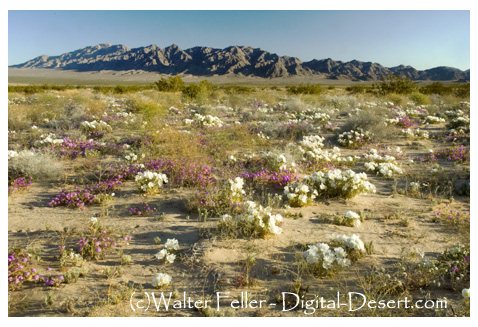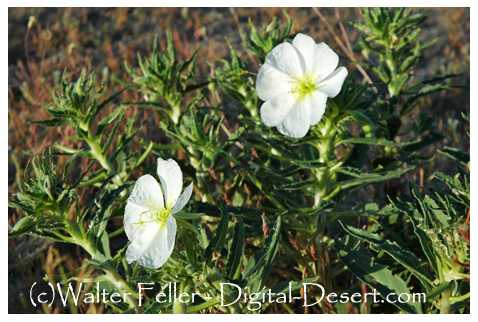The Basketmaker of the Desert
By MARY BEALNearly every desert visitor knows Evening Primrose—but not all of them know that the white-ribbed "baskets" so often found rooted in the sand are the dried stalks of this lovely white flower which blossoms at night and takes a siesta when the sun comes out.
THE botany books call them Oenotheras, but to you and me they are Evening Primrose. They greet the daybreak all tricked out in their best bib and tucker but before the sun is high they begin to droop and soon they have closed their petals for their daily siesta, which lasts until the lengthening shadows of evening revive their vibrant grace.
There are many members of the Evening Primrose family and they are among the most common of desert flowers— but common only in the sense that they grow everywhere in the arid region. There are two general groups—the one that sleeps when the sun is out and opens its blossoms at night, and another group which follows the more conventional habit of sleeping at night. The Desert Magazine this month will present only some of the day-sleepers.
One member of the Evening Primrose family is a skilled craftsman—and if you have tramped the desert sands you undoubtedly have seen her handiwork, perhaps without connecting it with the large-blossomed white Primrose that flowers after the winter rains.
She is a basketmaker. The baskets take form when the flowering season is over. You will recognize them from the picture on this page. The one in this photograph had resisted wind and rain for two and one-half years before I brought it in.
Of the two general divisions of Oenothera, one has a stigma divided into four linear lobes, and the other has a globose or disk-like stigma. The latter happens to be our Day Sleeper.
Oenothera trichocalyx
{Oenothera deltoides of some botanists}
Known as Basket Evening Primrose, it was Yerba Salada to Spanish California and must have been popular on the menus of those early days. After its salad days are over, basketwork is well underway but not completed until full maturity rounds out the life cycle.
Its unique baskets are fashioned in this wise. A stout erect stem two to eight inches high (rarely over one foot) and often cone-shaped, densely crowded with flowers, rises from the center of a grey-green rosette of velvety leaves. Skimpy rains curtail the growth to this simple form. With generous showers several branches, six to over 20 inches long, spread out from the base like spokes from the hub of a wheel, leaves and flowers adorning the up-turning ends. As they develop, the upward curve increases until maturity finds the tips meeting or overlapping above the center, forming a stiff round basket. These white skeletons stand indefinitely. The white flowers are two or three inches across, the four broad petals deeply notched, turning pink as they age. The slender, sessile capsules are much thickened at the base, recurved or reflexed when mature.
Occasionally individuals or groups are inclined to go off on tangents of their own. The main stem may be flattened to a width of three or four inches, perhaps flaring into a fanshaped top eight to over 12 inches wide, the whole densely covered with flowers. Several years ago I found a large colony of these individualists flourishing on the sandy flat verging upon the lava beds surrounding Mt. Pisgah on the Mojave desert. All the vagaries of self-expression were there in a superlative degree but each eccentric outdid itself in blooming. You'll be astonished to know the number of blossoms on some of these exuberant plants. Chosen at random in dry basket stage, two average specimens yielded a capsule count of nearly 1000 each. One center had 362 capsules, the other 306, the branches from 44 to 77 each. This species is abun- dant iri sandy areas at moderate altitudes in the Mojave and Colorado deserts and Arizona.
Oenothera caliiornica
A perennial with stems four to over 12 inches long, more or less trailing. The long rootstalk sends up many slender very leafy stems, loosely flowered. The downy narrow leaves, an inch or two long, are pale bluegreen with wavy margins, shallow toothed or lobed or entire. Regular day-sleepers are the white flowers, two or three inches broad, aging deep pink. The very slender, ribbed capsules vary from cylindrical to four-sided. Rather common in river bottoms, sandy flats and washe: of valley and mountains in all California desert regions, as well as nearer the Oenothera primiveris
Fron a perennial root the very short thick stem spreads out a broad rosette of narrow uowny leaves, two to seven and one-half in ches long, irregularly toothed or sometimes finely cut nearly to the mid-rib, on long petioles. The sparkling yellow flowers, aging pink, are two or three inches across and sessile, rising fiom the center on long calyx-tubes which resemble stems. The four-sided capsules arcmore or less ovate with ridged angles, and sometimes dotted with red glands. Consistently vespertine, they brighten few daylight hours but fwake they add charm to sands of the central and eastern Mojave and Colorado deserts, southern Nevada, Arizona, New Mexico and western Texas.
Oenothera caespitosa
(Oenothera caespitosa var. marginata) (Pachylophus marginatus)
Another perennial with variable, more or less hairy leaves, one to five inches long, growing in a basal tuft on long petioles. The foursided buds open into snowy white flowers, sometimes over three and one-half inches broad, aging pink, on stem-like calyx-tubes three to five and one-half inches long. The four-sided capsules are broadly linear to narrowly ovate with nubby ribs or narrow, toothed wings. Sandy stretches in the canyons of the Providence mountains have yielded my best specimens and only last spring a freakish caesjutosa in lower Bonanza King canyon challenged my credulity when I discovered it dangling in mid-air from a long rootstalk stretched from a crevice in the overhanging rock wall. Sandy slopes and washes are its usual habitat, in the Inyo and Mojave deserts from moderate altitudes to 7500 feet.
article - Desert Magazine, April 1938 - photos copyright Walter Feller


